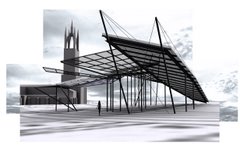I was reading "Responsive Environments: Architecture Art and Design" (amazon link) by Lucy Bullivant (she edited "4D Space Interactive Architectue" (credit again to www.interactivearchitecture.org for pointing me towards this book) and a rather phrase was used which whilst seeming quite vague could be useful in focussing my work:
"Evolving effective responsive sytems, and creating a credible interface between the work and the user, requires an awareness of many different types of user, contexts and functions as well as the phenomenological aspects of social and environmental conditions."
Whilst not being prescriptive, it does give a number of key points for direction in a project which I think can be applied for developing an Idea Store brief. (At this point I am uncomfortable with the term "Idea Store" as it seems is a buzzword for a building type which appears to be more of a re-branding of librarys than delivering something as innovative as it could be.
So things to consider:
Different types of users and their requirements - public, private, changing over a short period of time and dependent on different functional requirements of the brief.
Different contexts in which the building can operate - different times of day... eg on a friday night the use of the building could be drastically different than at 4pm on a weekday.
Different functions or modes of operation of the building - again different times of day could have an impact on the different functions the building posesses. The accomodation of facilities such as exhibition spaces, dance spaces as well as traditional functions should be considered together in conjunction with how this could change according to time of day (and also possibly future change of functions?)
Phenomenological, Social and Environmental conditions - the perception of the building, how this changes according to outside change (weather, context change, interaction, function) and the functional intearction of the building is important here. These aspects need to be woven into the rest of the buidling conecpt (in a form/function type relationship) and offer potential for artistic/creative uses of technologies and the responsive nature of the building. Environmental change is something that responsive buildings have investigated (the most mundane being Building management systems going to responding physically and change of the buildings form based on airflow - see Office for Robotic Architecture).
Food for thought.... (and action - I think that in developing the project, the meat of the design process will be in actually working up the project, playing with different ideas/response/technology and actually designing the building... will elaborate on this later too).
Sunday, August 27, 2006
Subscribe to:
Post Comments (Atom)

No comments:
Post a Comment